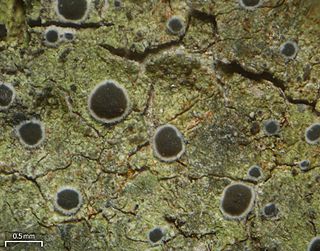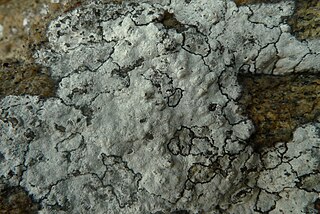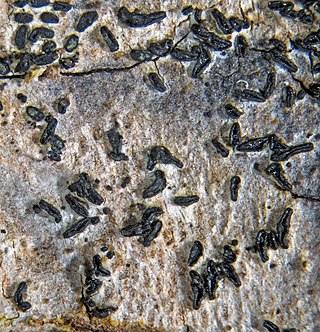
The Arthoniales is the second largest order of mainly crustose lichens, but fruticose lichens are present as well. The order contains around 1500 species, while the largest order with lichenized fungi, the Lecanorales, contains more than 14000 species.

The Arthoniaceae are a family of lichenized, lichenicolous and saprobic fungi in the order Arthoniales. The Arthoniaceae is the largest family of Arthoniales, with around 800 species. Most species in Arthoniaceae belong in Arthonia which is the largest genus with 500 species. The second and third largest genus is Arthothelium with 80 species, and Cryptothecia with 60 species.

The Roccellaceae are a family of fungi in the order Arthoniomycetes. Most taxa are lichenized with green algae, although some are lichenicolous, growing on other lichens.

The Pilocarpaceae are a family of crustose lichens in the order Lecanorales. The species of this family have a cosmopolitan distribution and have been found in a variety of climatic regions. Pilocarpaceae was circumscribed by Alexander Zahlbruckner in Adolf Engler's influential 1905 work Die Natürlichen Pflanzenfamilien.

The Acarosporaceae are a family of fungi in the order Acarosporales. Members of this family have a widespread distribution, and are mostly lichenized with green algae. According to a 2021 estimate, the family contains 11 genera and about 260 species. The family is characterised by a hamathecium formed of paraphysoids.

Enterographa is a genus of lichens in the family Roccellaceae.
Pentagenella is a genus of lichen-forming fungi in the family Opegraphaceae. It contains five species.

Lecanographa is a genus of about 40 species of lichens in the family Lecanographaceae. It was circumscribed in 1994 by José M. Egea and Pilar Torrente, with Lecanographa lyncea as the type species.

Lecanactis is a genus of crustose lichens, commonly called old wood rimmed lichen. The genus was circumscribed in 1855 by German lichenologist Gustav Wilhelm Körber, who assigned Lecanactis abietina as the type species.

Roccellographa is a genus of lichen-forming fungi in the family Roccellographaceae. The genus was circumscribed by Austrian lichenologist Julius Steiner in 1902, with Roccellographa cretacea assigned as the type, and at that time, the only species. Three additional species have since been transferred to the genus from other genera.

Schizopelte is a genus of lichen-forming fungi in the family Opegraphaceae. The genus was circumscribed by Theodor Magnus Fries in 1875. It was resurrected for use in 2011 by Damien Ertz and Anders Tehler, who published a phylogenetic study of the order Arthoniales. In addition to the type species, S. californica, they included a former Hubbsia species, a former Llimonaea species, and a species new to science in the resurrected Schizopelte.
Tania is a genus of lichenized fungi in the family Roccellaceae. It has two species. The genus was circumscribed by Maria Egea Fernández, Pilar Torrente and Harrie Sipman in 1995, with Tania lanosa assigned as the type, and at that time, only species. A second species, T. mohamedii, was added to the genus in 2006. The genus name honours bryologist Benito Ching Tan (1946–2016), who organized the expedition to Mount Kinabalu and collected the type species with Sipman.

Alyxoria is a genus of lichen-forming fungi in the family Lecanographaceae.

Roccellographaceae is a family of lichen-forming fungi in the order Arthoniales. It contains three genera: Dimidiographa, Fulvophyton, and Roccellographa.
Vigneronia is a genus of lichen-forming fungi in the family Roccellaceae. It has five species. The genus was circumscribed in 2014 by Damien Ernst, with Vigneronia spieri assigned as the type species. This species, originally described as Schismatomma spieri from collections made in the Galápagos Islands, has since been recorded from mainland Ecuador and the Antilles (Curaçao). The genus is named after Ernst's wife, Nathalie Vigneron, who accompanied him on collecting trips.
Gyrographa is a genus of lichen-forming fungi in the family Roccellaceae. The genus was circumscribed in 2014 by Damien Ernst and Anders Tehler, with Gyrographa gyrocarpa assigned as the type species. This lichen, originally described by Julius von Flotow in 1825, was first placed in the genus Opegrapha. Species in the genus have a crustose thallus lacking a cortex, and a dark brown prothallus. The photobiont partner is trentepholioid. The hypothecium is thick and carbonised, and the ascospores lack a gelatinous sheath; these characteristics distinguish it from Opegrapha species. The genus name alludes to the gyrose ascomata of the type species.
Ocellomma is a genus of lichen-forming fungi in the family Roccellaceae. The genus was circumscribed in 2014 by Damien Ertz and Anders Tehler, following a molecular phylogenetic-based revision of the Roccellaceae. The type species, O. picconianum, was originally named Lecania picconiana by Francesco Baglietto in 1862, described from specimens collected in Italy. DNA-based phylogenetic analysis showed that it occupied a distinct genetic lineage, deserving of recognition as a new genus. The genus name Ocellomma alludes to the whitish rims on the small ascomata that contrast with the discs, giving them the appearance of small eyes.
Dimidiographa is a genus of lichen-forming fungi in the family Roccellographaceae. It has three species of crustose lichens, with Dimidiographa loandensis serving as the type species.
Fouragea is a genus of lichen-forming fungi in the family Opegraphaceae. It has nine species.

Fulvophyton is a genus of lichen-forming fungi in the family Roccellographaceae. It has 11 species. Fulvophyton is characterised by its crust-like thallus, which is often pale yellowish-brown in colour. This genus features a photobiont from the green algal genus Trentepohlia and exhibits a unique arrangement of reproductive structures.












